
A large neighbourhood to the north of Beihai Park is still old, it includes the Hohai lakes, the Bell and Drum towers and the Jiaodouku residential area.
Projects in Beijing |
 A large neighbourhood to the north of Beihai Park is still old, it includes the Hohai lakes, the Bell and Drum towers and the Jiaodouku residential area. |
||
| Introduction Beijing is one of the world’s oldest centrally-planned cities. The historic centre has been laid out in the Yuan dynasty along a rectangular grid with the Imperial Palace in the centre. The narrow alleyways, called Hutongs, are lined by single-storey courtyard houses built in traditional Chinese architecture with curved roofs. |
||
|
Since the 1990s, as in most other Chinese cities, Beijing’s historic
residential sections have increasingly been redeveloped under the Weigai
system. The old alleyways and traditional-style buildings are disappearing,
and the residents are often moved to remoter parts of the city. The historic
grid pattern is superseded by a network of wide and modern roads that
hope to cope with the increasing traffic. The resulting loss of much of
Beijing’s urban heritage has been almost universally recognized as
regrettable. Taking the considerations of archaeologists, historians and
the wider public into account, the government has in recent years decided
to list an increasing number of Hutong (alley) sections as protected.
What exactly will happen to the protected areas still remains unsolved. The old and the new face of Beijing |
 |
|
THF experts have spent extended periods of time in Beijing since the year 2000. We were not only fascinated by this ancient and yet vibrant city, but we also found the conditions and problems of the old residential neighbourhoods entirely comparable to those of Lhasa. We felt that the experience made in the Lhasa Old City rehabilitation project could be used to solve some of Beijing’s problems. 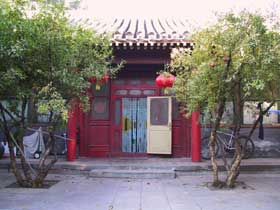 Xianming Hutong - not all Hutong homes are dilapidated, many are well-kept. |
The city needed solutions that would preserve the character as well as the fabricof the old neighbourhoods, solutions that were sustainable, and community-friendly. In order to develop a suitable rehabilitation program, we began a cooperation with the School of Architecture of Tsinghua University and local administrative offices. For the next several months, three sections of the 25 protected areas were subject to detailed architectural and social surveys. Early results were introduced at an international conference hosted by Tsinghua, and supported by the Embassies of France and Germany and by UNESCO. Since then, work has progressed. Detailed rehabilitation and conversion plans for several courtyard structures have been prepared in close consultation with the current residents. We are now proposing to implement a pilot project and are in discussion with Chinese counterparts about it. A detailed report is available, in Chinese and in English. |
|
| Zhong-Gulou area (Bell and Drum
tower area) Map showing area around the Drum and the Bell towers. Colour marks surveyed buildings. |
||
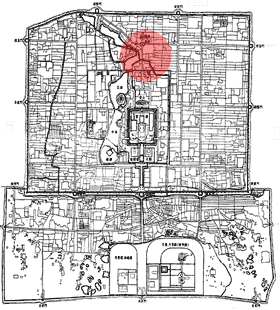 Inner City of Beijing, the pink spots indicate the blocks that were studied in detail (right) |
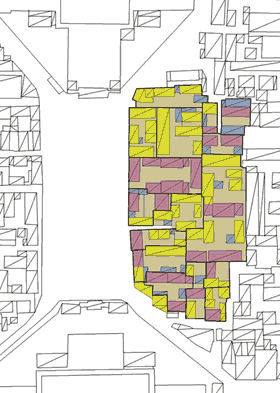 |
|
| The old neighbourhoods are laid out on a rectangular grid pattern that dates back to the 12th century. The narrow lanes are called Hutongs. | Zhonglouwan street, present condition red = historic building blue = non-permanent extension brown = open space yellow = modern but traditional building |
|
The Gulou area,centred on the famous Drum and Bell towers, is one of Beijing ’s most atmospheric neighborhoods. It is located at the northern end of the axis that runs North-South, through the centre of the Imperial Palace complex. Originally built in the 13th century, the towers were used throughout the Ming and Qing dynasties to sound out the progress of time.The ringing of the bell and beating of the drum informed citizens of the time of day and also indicated the specific days of the lunar calendar. The towers are now museums recognised as important historic monuments. Today,the two towers stand at either end of a small square surrounded by old residential courtyard houses. |
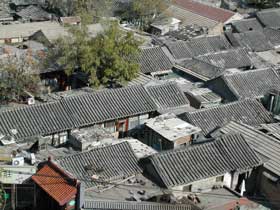 View from Drum tower, showing the typical Hutong neighbourhood structure |
|
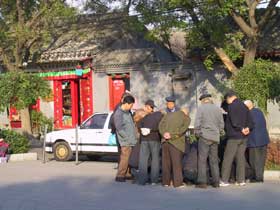 |
An important feature of the Gulou area is the integration of historic
monuments within a vibrant residential area. Plans to replace residential
buildings with a parking lot for tourist busses are akin to killing the
goose that lays the golden egg. |
|
| Top |
|
Copyright, Tibet Heritage
Fund
|